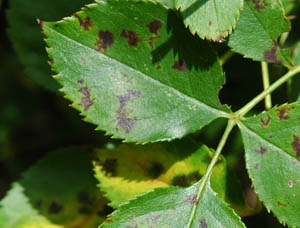Black Spot of Rose | |
|---|---|
| July 3, 2006 | |
|
Black spot of rose is caused by a fungus, Marssonina rosae (Diplocarpon rosae). It can cause major defoliation of rose and can weaken the plant, making it more susceptible to winter injury and decline from other diseases. We donít see this very often in the University of Illinois Plant Clinic because the disease is easily identified. It is out there now, so start checking your plants. There is a wide range of resistance available to this disease, with some varieties still very susceptible. It is the susceptible ones that you need to watch. Cultivars of floribundas, shrub roses, and climbing roses are most resistant to black spot, while hybrid teas, grandifloras, and miniatures are least resistant. Chemical options are protectants, with sprays initiated as new leaves appear and continuing according to label directions well into the fall. There are many products available to control black spot. When deciding on a product, also consider other diseases that the fungicide controls. Powdery mildew, rust, and downy mildew are the other major concerns. Issue no. 10 in the 2005 series of this newsletter provides a table with fungicide active-ingredient efficacy against these four rose diseases. Symptoms of black spot include brown to black spots on the upper or lower leaf surface; on petioles, stems, or flowers. The leaf spots are easy to diagnose, with fringed margins and lack of distinct fruiting bodies. The image shows typical leaf symptoms.  The black spot fungus overwinters on rose canes and on plant debris on the ground. Fall cleanup around roses is definitely beneficial. Secondary infection occurs throughout the season in moist, warm weather. The pathogen thrives in relative humidity of 85% or higher and temperatures of 75ļ to 85 degrees F. It is beneficial to plant roses with spacing that promotes good air circulation among plants. This encourages more rapid drying and conditions that are not as favorable to infection by the black spot fungus. Try to avoid watering the foliage of roses. If overhead watering is necessary, do so early in the day to be sure that foliage dries quickly. A disease report on black spot is available on the Vista Web site at http://www.ag.uiuc.edu/%7Evista/horticul.htm as Report on Plant Disease, no. 610. |